Washing Machine Repair
NOTE: Chapter 2 covers problems common to almost all washer designs.
THIS chapter covers only diagnosis and repairs peculiar to Herrin-design washing machines.
If you do not read Chapter 2 thoroughly before you read this chapter,
you probably will not be able to properly diagnose your machine!!!!
This machine was originally designed by Norge, who was later bought by Maycor (Maytag.) In the latest incarnation, Maycor is putting out their version of the old Norge design as "Performa" model Maytag machines, as well as Magic Chef, Admiral and Crosley brands. Maytag "Atlantis" machines are basically souped-up Performas, with more solid-state controls and digital gadgetry.
Note that Signature (Montgomery Ward) machines were, at various times over the last 20 years or so, built to either a Norge or Frigidaire design. Please look at both this chapter and chapter 10, Frigidaire, and figure out what kind of washing machine you have before you try to diagnose it!
Performa washing machines use a direct reversing drive motor to change from agitate to the spin cycle. Single, two- and three-speed motors were used in various models. Power is transmitted to the pump and transmission by a single belt. The motor is mounted on plastic mounts that slide in tracks in the baseplate of the machine. A large spring pushes the motor in its sliding tracks to keep tension on the belt. During the spin cycle, the whole transmission casing spins around; a clutch built into the transmission allows the transmission to accelerate slowly, allowing for a "pre-pump" action. During the agitate cycle, a brake keeps the transmission from spinning, and the gears inside the transmission operate the agitator.
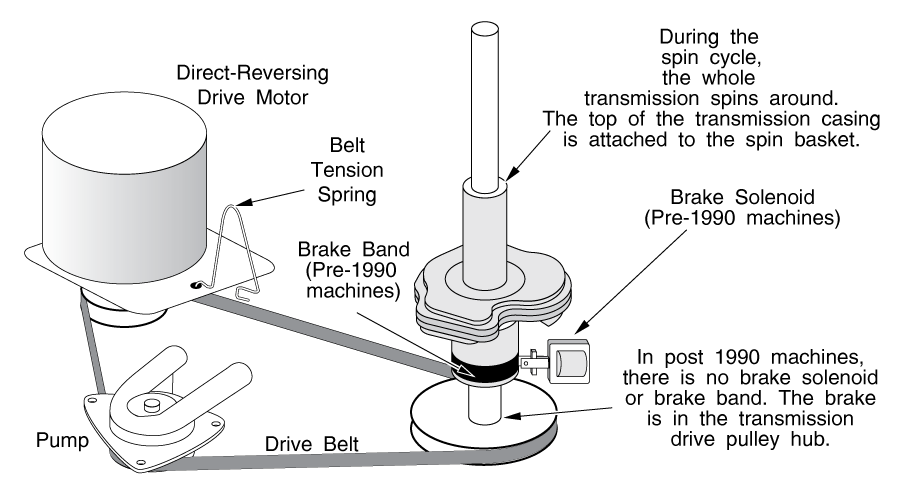
Before 1990, these machines used a solenoid-operated brake band around the base of the transmission housing to stop the transmission from spinning. In more recent models, a cam in the transmission pulley hub allows the brake to engage when the motor is turning in the "agitate" direction, but releases it when the motor turns in the "spin" direction. For the purposes of this book, these washing machines will be referred to as pre-1990 or post-1990 machines, identifiable by the presence or absence of a brake band at the bottom of the transmission housing. (Figure N-1a)
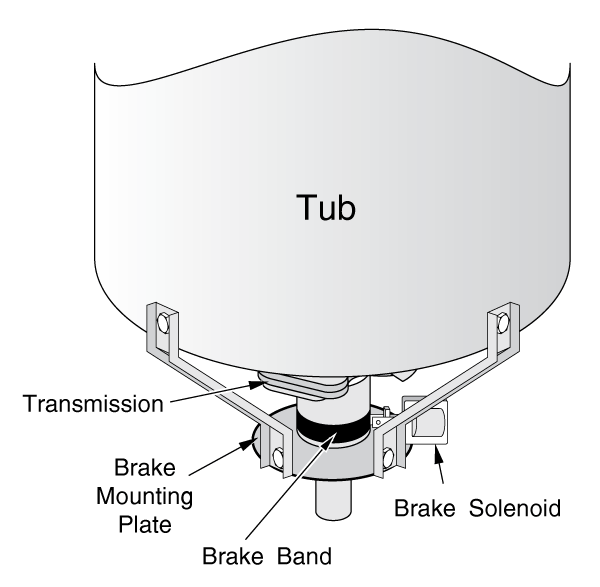
In pre-1990 models, the machine does not start spinning until the tub is partially pumped out. This is accomplished in one of two ways.
In most machines, the timer holds the brake for a minute and a half or so at the beginning of the spin cycle while the pump starts draining the tub. In just a few models, a "dashpot" was used. It looks like a diaphragm switch mounted piggyback to the brake solenoid. It is simply a pressure switch that senses water level in the tub, and releases the brake at the appropriate water level. Replace if defective. In a few very old pre-1990 machines, there is a solenoid-activated clutch that works in conjunction with the brake. (I don't know if there are still any operating out there; frankly, I've never seen any.)
The cabinet and console may be opened for service as shown in figure N-2. Please note that the front panel cannot be lifted off the machine until the cabinet top has been raised.
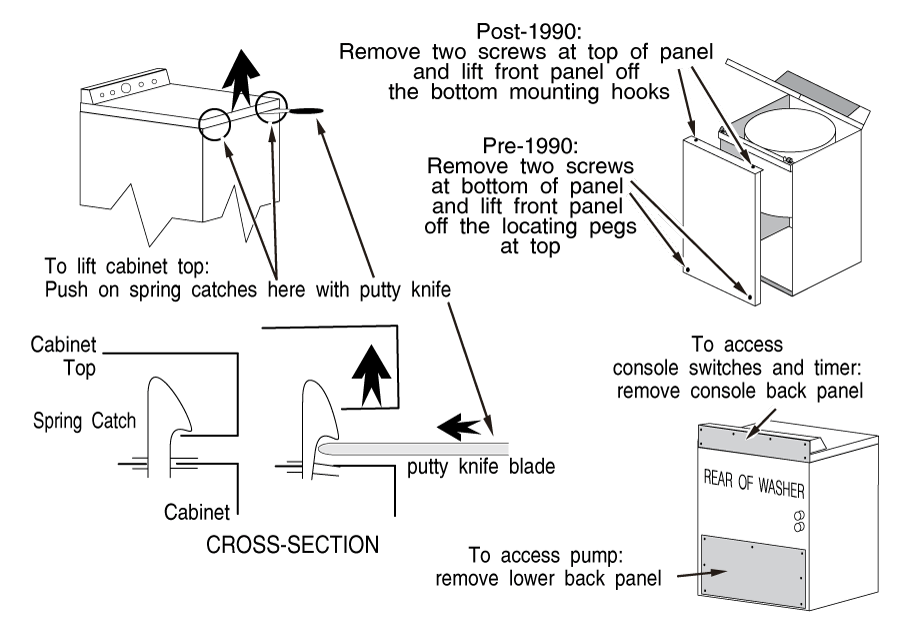
Well, we have good news and bad news here. The good news is that Norge design machines are pretty tough and seem to last at least a good 8 to 10 years.
The bad news is that transmission, tub seal or upper (spin) bearing repairs are extremely difficult and expensive and require many special tools, and thus usually render the machine not economically worth repairing.
Here are the most common problems with these machines:
SYMPTOM: LEAKS
Leaking pumps are the single most common problem with this machine, and they are easy to replace. See section 7a-4. See also TUB SEAL LEAKS below.
SYMPTOM: NO DRAIN
If the machine is not draining, there may not be enough belt tension on the pump belt; check for a broken belt or tensioning spring.
The belt is subject to normal wear as described in Chapter 2, section 2-5(a). If you have belt wear problems, also check the motor tracks and belt-tensioning spring as described in section 7a-5.
The motor tracks may be mucked up or corroded, preventing the motor from "floating" in its track enough to tension the belt.
SYMPTOM: NO AGITATION, NO SPIN, OR SLOW SPIN
This may be caused by a number of different problems. The first thing to determine is whether or not the motor is turning, and the belt is turning the transmission. If not, you may have belt problems, timer or motor problems, or speed selector switch or lid switch problems as described in Chapter 2. If the motor is turning, you may have brake bearing or spin bearing problems; see sections 7a-6 and 7a-7.
SYMPTOM: NOISES AND TUB SEAL LEAKS
A squeak during braking in post-1990 models can be solved by sanding the rotor drum surface lightly with emery cloth, but it is not an easy job. The brake spring is heavily pre-loaded and requires some special tools to remove and install safely. See section 7a-6.
A rattling noise can indicate a worn flexible rubber bushing in the motor drive pulley hub. See section 7a-6.
A rumbling sound is usually an upper (spin) bearing problem. This may also come across as a sound like a jet engine or a Ferrari taking off as the machine accelerates into the spin cycle (an accelerating whe-e-e-e-e sound). This is often accompanied by water leaking from the tub seal above the transmission; look around the inside walls of the cabinet for signs of water slinging off the transmission during the spin cycle. See section 7a7. In pre-1990 models, a rumbling or growling sound can also indicate bad bearings in the transmission drive pulley assembly. See section 7a-6.
SYMPTOM: VIBRATION
Vibration in these machines usually occurs because of bleach leaks. There is a bleach dispensing cup molded into the top of the tub ring. Bleach spits out of this cup, and drips down around the baseplate of the washer. The baseplate and cabinet quickly rust, and the baseplate suspension spring mounts or even the suspension springs themselves may crack or break. If a suspension spring on one side is broken or disabled, the washer will vibrate badly.
You can try to replace a broken suspension spring (if you must replace one, you must replace the whole set). However, it can be very difficult, and it requires expensive special tools. Normally there is no repair for this problem. If the baseplate of the washer is badly corroded, you will probably end up scrapping the washer soon.
SYMPTOM: BRAKE AND BRAKE SOLENOID
In pre-1990 models, if the basket tries to spin with the tub full of water, the brake is not engaging. You will find the brake assembly mounted to the plate near the bottom of the transmission (Figure N-1a). Check the brake solenoid and dashpot (if installed) Also check the linkage and the brake band. Test the solenoid as described in section 2-6(a). Replace if defective.
Though the brake solenoid is relatively easy to replace, the brake band is extremely difficult, requiring special tools. If the lining or band needs service, or if the brake is squealing, call a qualified service technician or junk the washer.
The pump is accessed through the rear cabinet panel. To remove it, simply remove two hoses, then the three screws that hold it in place. When installing, reach underneath and make sure the belt is properly seated on the pump, motor and transmission pullies.
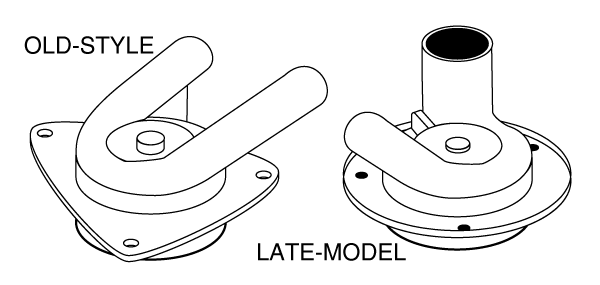
The motor is mounted in two plastic mounts (Figure N-4) which slide into slots in the motor base. Make sure these tracks are free of any detergent buildup or anything else that might restrict the free movement of the motor. Also check that the belt tensioning spring is in the right place (Figure N-4) and is not broken.
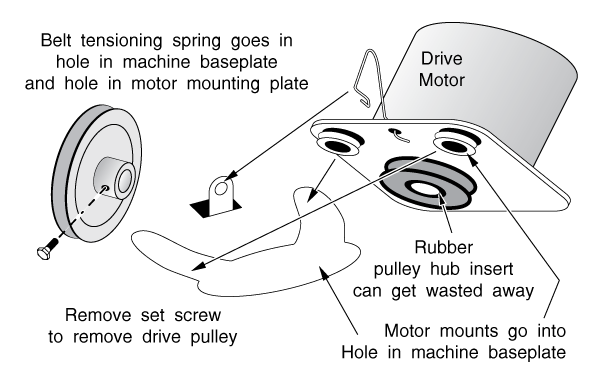
Some of these machines used a motor pulley with a flexible rubber hub which tends to disintegrate after a few years. If the pulley literally flops around on its hub with the belt tension removed from it, that's what's happened. Replacements are available; to remove the pulley, remove the setscrew as shown in figure N-4.
Some late model machines have a nylon/fiberglass motor pulley that is pressed onto a splined motor shaft. It can be replaced if damaged, but it requires a puller to get it off. Reinstalling it, tap it onto the motor shaft with a 1/2 inch socket until it bottoms on the shoulder on the motor shaft. To prevent motor bearing damage when you tap it on, make sure you remove the plastic shaft cover on the other end of the motor and back up the shaft against something solid. (Like a wall or workbench.)
In pre-1990 models, the transmission drive pulley and its bearing are located in the center of the baseplate. The bearing within the plate can get rusted or worn, causing noise and excessive belt wear. They are difficult to replace. If this happens, call a qualified service technician.
The transmission drive pulley in post-1990 machines is made of a plastic material. The bearing assembly is pictured in figure N-5. When disassembling this assembly, count the pieces beneath the pulley; there should be six. When this bearing gets severely worn, the lower washer will embed itself into the plastic pulley, and you may only count five pieces. There may be powdered plastic or metal residue or pieces of the pulley on the other bearing assembly parts. The symptom will be that the basket is not spinning; the reason is that due to the wear in this bearing, the brake is not lifting enough to release and allow the transmission to spin. A kit is available to replace the pulley and bearing assembly.
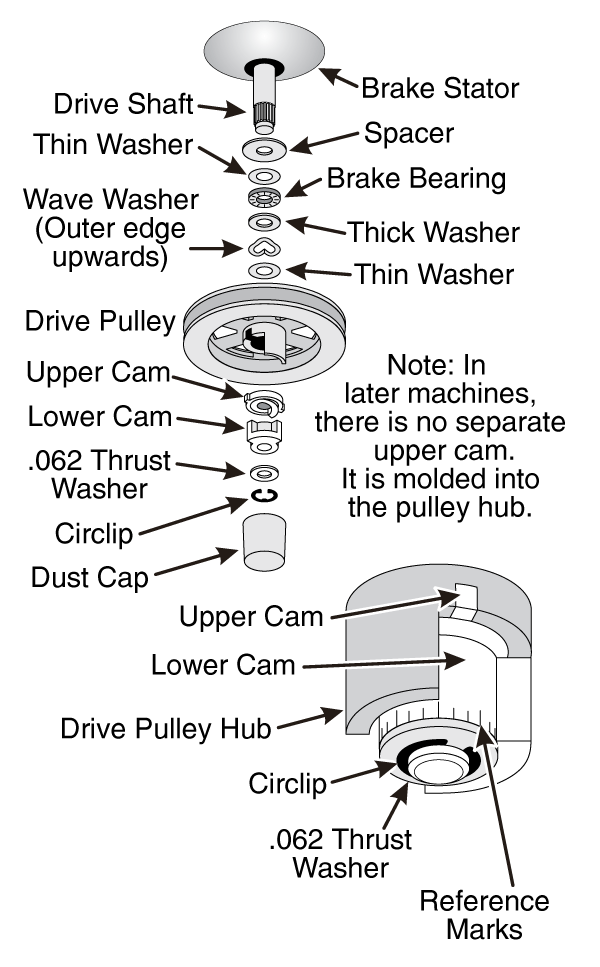
You may need to adjust the brake release. After you replace the bearing assembly, turn the pulley CCW until the brake releases. Look at the reference marks on the lower cam; each mark is worth about .010 of adjustment. The brake should release when the drive pulley hub shoulder is between 3 and 9 marks on the lower cam. Less than 3, and you need to replace the .062 thrust washer with a .032 thrust washer. If the brake releases at more than 9 marks, install both the .032 thrust washer and the .062 washer.
Brake squeaking can usually be quieted by removing the brake housing and lightly sanding the metal rotor drum surface with emery cloth to break the glaze. However, the brake spring is loaded to 200 pounds and requires a special tool (number 35-2442) to remove. Your parts distributor may have one in stock, but for most distributors it is usually a special order.
If you have upper or lower spin bearing or tub seal leakage problems, you will probably end up junking the washer. The transmission is a real son-of-a-gun to remove. First, it takes about $200 worth of special tools, in addition to the parts cost. And speaking of parts costs, the upper bearing surface is the transmission casing itself, and usually the whole transmission must be replaced due to rust and wear. The suspension springs are heavily loaded and difficult and dangerous to remove. The set screw in the drive block is usually corroded so badly that it cannot be removed.
If you have symptoms that indicate a transmission problem on your washing machine, you might try calling a qualified service technician. However, be forewarned: if you can find a technician who's willing to do the job, it will probably cost you 350 dollars or more. Unless you're emotionally attached to the washer, it's usually not worth it. Sorry to be the bearer of bad tidings, but in my experience, you will usually end up getting rid of the washing machine.
Please share our .
